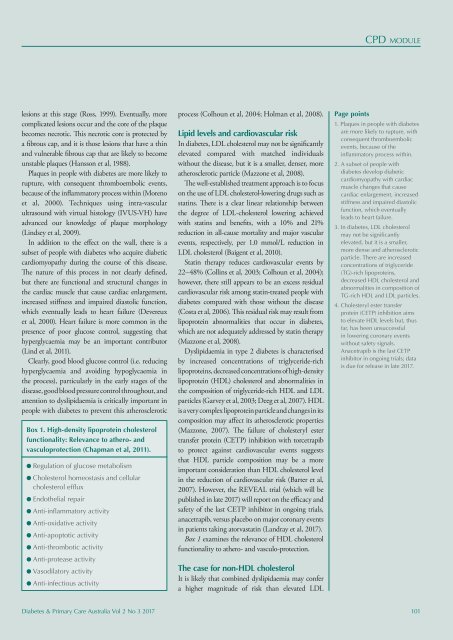DPCA 2-3_100-110
Create successful ePaper yourself
Turn your PDF publications into a flip-book with our unique Google optimized e-Paper software.
CPD module<br />
lesions at this stage (Ross, 1999). Eventually, more<br />
complicated lesions occur and the core of the plaque<br />
becomes necrotic. This necrotic core is protected by<br />
a fibrous cap, and it is those lesions that have a thin<br />
and vulnerable fibrous cap that are likely to become<br />
unstable plaques (Hansson et al, 1988).<br />
Plaques in people with diabetes are more likely to<br />
rupture, with consequent thromboembolic events,<br />
because of the inflammatory process within (Moreno<br />
et al, 2000). Techniques using intra-vascular<br />
ultrasound with virtual histology (IVUS-VH) have<br />
advanced our knowledge of plaque morphology<br />
(Lindsey et al, 2009).<br />
In addition to the effect on the wall, there is a<br />
subset of people with diabetes who acquire diabetic<br />
cardiomyopathy during the course of this disease.<br />
The nature of this process in not clearly defined,<br />
but there are functional and structural changes in<br />
the cardiac muscle that cause cardiac enlargement,<br />
increased stiffness and impaired diastolic function,<br />
which eventually leads to heart failure (Devereux<br />
et al, 2000). Heart failure is more common in the<br />
presence of poor glucose control, suggesting that<br />
hyperglycaemia may be an important contributor<br />
(Lind et al, 2011).<br />
Clearly, good blood glucose control (i.e. reducing<br />
hyperglycaemia and avoiding hypoglycaemia in<br />
the process), particularly in the early stages of the<br />
disease, good blood pressure control throughout, and<br />
attention to dyslipidaemia is critically important in<br />
people with diabetes to prevent this atherosclerotic<br />
Box 1. High-density lipoprotein cholesterol<br />
functionality: Relevance to athero- and<br />
vasculoprotection (Chapman et al, 2011).<br />
l Regulation of glucose metabolism<br />
l Cholesterol homeostasis and cellular<br />
cholesterol efflux<br />
l Endothelial repair<br />
l Anti-inflammatory activity<br />
l Anti-oxidative activity<br />
l Anti-apoptotic activity<br />
l Anti-thrombotic activity<br />
l Anti-protease activity<br />
l Vasodilatory activity<br />
l Anti-infectious activity<br />
process (Colhoun et al, 2004; Holman et al, 2008).<br />
Lipid levels and cardiovascular risk<br />
In diabetes, LDL cholesterol may not be significantly<br />
elevated compared with matched individuals<br />
without the disease, but it is a smaller, denser, more<br />
atherosclerotic particle (Mazzone et al, 2008).<br />
The well-established treatment approach is to focus<br />
on the use of LDL cholesterol-lowering drugs such as<br />
statins. There is a clear linear relationship between<br />
the degree of LDL-cholesterol lowering achieved<br />
with statins and benefits, with a 10% and 21%<br />
reduction in all-cause mortality and major vascular<br />
events, respectively, per 1.0 mmol/L reduction in<br />
LDL cholesterol (Baigent et al, 2010).<br />
Statin therapy reduces cardiovascular events by<br />
22–48% (Collins et al, 2003; Colhoun et al, 2004);<br />
however, there still appears to be an excess residual<br />
cardiovascular risk among statin-treated people with<br />
diabetes compared with those without the disease<br />
(Costa et al, 2006). This residual risk may result from<br />
lipoprotein abnormalities that occur in diabetes,<br />
which are not adequately addressed by statin therapy<br />
(Mazzone et al, 2008).<br />
Dyslipidaemia in type 2 diabetes is characterised<br />
by increased concentrations of triglyceride-rich<br />
lipoproteins, decreased concentrations of high-density<br />
lipoprotein (HDL) cholesterol and abnormalities in<br />
the composition of triglyceride-rich HDL and LDL<br />
particles (Garvey et al, 2003; Deeg et al, 2007). HDL<br />
is a very complex lipoprotein particle and changes in its<br />
composition may affect its atherosclerotic properties<br />
(Mazzone, 2007). The failure of cholesteryl ester<br />
transfer protein (CETP) inhibition with torcetrapib<br />
to protect against cardiovascular events suggests<br />
that HDL particle composition may be a more<br />
important consideration than HDL cholesterol level<br />
in the reduction of cardiovascular risk (Barter et al,<br />
2007). However, the REVEAL trial (which will be<br />
published in late 2017) will report on the efficacy and<br />
safety of the last CETP inhibitor in ongoing trials,<br />
anacetrapib, versus placebo on major coronary events<br />
in patients taking atorvastatin (Landray et al, 2017).<br />
Box 1 examines the relevance of HDL cholesterol<br />
functionality to athero- and vasculo-protection.<br />
The case for non-HDL cholesterol<br />
It is likely that combined dyslipidaemia may confer<br />
a higher magnitude of risk than elevated LDL<br />
Page points<br />
1. Plaques in people with diabetes<br />
are more likely to rupture, with<br />
consequent thromboembolic<br />
events, because of the<br />
inflammatory process within.<br />
2. A subset of people with<br />
diabetes develop diabetic<br />
cardiomyopathy with cardiac<br />
muscle changes that cause<br />
cardiac enlargement, increased<br />
stiffness and impaired diastolic<br />
function, which eventually<br />
leads to heart failure.<br />
3. In diabetes, LDL cholesterol<br />
may not be significantly<br />
elevated, but it is a smaller,<br />
more dense and atherosclerotic<br />
particle. There are increased<br />
concentrations of triglyceride<br />
(TG)-rich lipoproteins,<br />
decreased HDL cholesterol and<br />
abnormalities in composition of<br />
TG-rich HDL and LDL particles.<br />
4. Cholesteryl ester transfer<br />
protein (CETP) inhibition aims<br />
to elevate HDL levels but, thus<br />
far, has been unsuccessful<br />
in lowering coronary events<br />
without safety signals.<br />
Anacetrapib is the last CETP<br />
inhibitor in ongoing trials; data<br />
is due for release in late 2017.<br />
Diabetes & Primary Care Australia Vol 2 No 3 2017 101
















